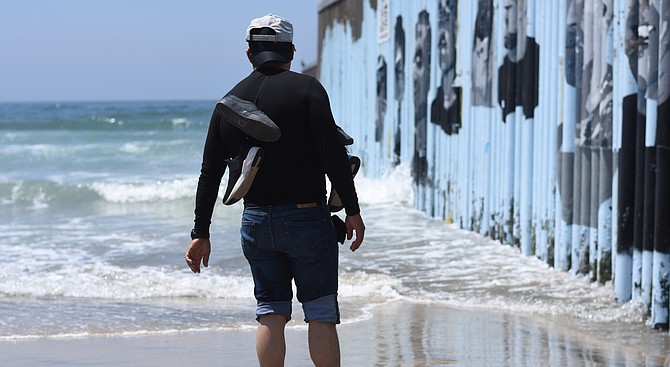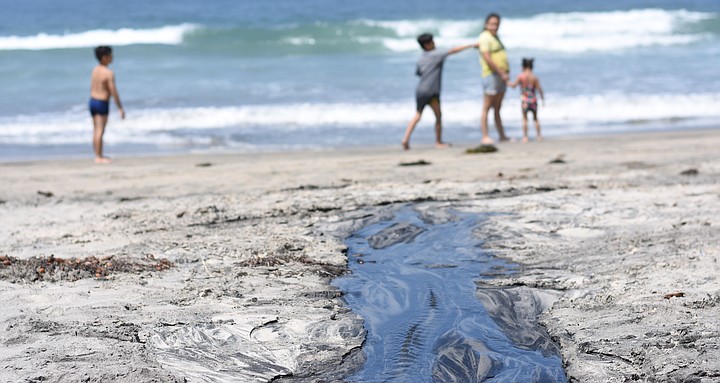 Facebook
Facebook
 X
X
 Instagram
Instagram
 TikTok
TikTok
 Youtube
Youtube

Playas de Tijuana still in the top five of the most contaminated beaches in Mexico
According to the Federal Commission of Sanitation Risks, Playas de Tijuana is still one of the five most contaminated beaches in Mexico and, because of its recent reopening to the public sewage spills are affecting the local tourism. Jorge Jesus Ramirez, a restaurant owner in the tourist area in Playas, said that the institution in charge, the State Public Services Commission in Tijuana, is not doing its work properly.

“We have been seriously affected by the smell, they plugged our pipes and did a terrible job trying to fix our problem. I’m paying taxes and they made a mess here. On top of that, there’s not proper maintenance of the pier in Playas. It has to be constant, not every three years when a new mayor gets to the office.”
Juan Aguilar, a coconut vendor, noted that every business in Playas is affected by the smell, and because of it paisanos who visit Tijuana don’t want to eat. In his opinion, fewer people come because they can’t get in the ocean. “Sometimes you can see how dirty the water is. Visitors just don’t know; they are the only ones that go in, but we locals know it could be dangerous.”
The federal commission mentioned above tests on 265 beaches in Mexico, 5 of them had more than 200 enterococcus (fecal material) present in 100 militates of water.
Abraham García co-founder of the non-profit Kilometro 1, which started as a group of young people cleaning up the beach of plastic, explained that Playas de Tijuana is not known by its beauty, but is emblematic because of the border wall and has been the Corner of Latin America.
“We began focusing on plastic waste but got involved in other fields to conserve our beaches. The sewage discharges in the ocean have existed for years; they are not treated properly. Part of the excuse of the institution in charged is their lack incomes due to people’s debts, which affects the budget they have to invest in their infrastructure maintenance." It's easy to find pipes discharging sewage directly to the ocean and end in Playas de Tijuana and in San Diego, for instance Imperial Beach.
“A surfer friend of mine actually got hepatitis and was hospitalized several days after surfing.”
Jose Barrera who lives in Playas de Tijuana and fishes recreationally, said that it can be dangerous for kids because they can swallow this water. The Fire Department in Tijuana in charge of the Coast Guard, which trains its collaborators in Playas de Tijuana, did not want to comment.


Playas de Tijuana still in the top five of the most contaminated beaches in Mexico
According to the Federal Commission of Sanitation Risks, Playas de Tijuana is still one of the five most contaminated beaches in Mexico and, because of its recent reopening to the public sewage spills are affecting the local tourism. Jorge Jesus Ramirez, a restaurant owner in the tourist area in Playas, said that the institution in charge, the State Public Services Commission in Tijuana, is not doing its work properly.

“We have been seriously affected by the smell, they plugged our pipes and did a terrible job trying to fix our problem. I’m paying taxes and they made a mess here. On top of that, there’s not proper maintenance of the pier in Playas. It has to be constant, not every three years when a new mayor gets to the office.”
Juan Aguilar, a coconut vendor, noted that every business in Playas is affected by the smell, and because of it paisanos who visit Tijuana don’t want to eat. In his opinion, fewer people come because they can’t get in the ocean. “Sometimes you can see how dirty the water is. Visitors just don’t know; they are the only ones that go in, but we locals know it could be dangerous.”
The federal commission mentioned above tests on 265 beaches in Mexico, 5 of them had more than 200 enterococcus (fecal material) present in 100 militates of water.
Abraham García co-founder of the non-profit Kilometro 1, which started as a group of young people cleaning up the beach of plastic, explained that Playas de Tijuana is not known by its beauty, but is emblematic because of the border wall and has been the Corner of Latin America.
“We began focusing on plastic waste but got involved in other fields to conserve our beaches. The sewage discharges in the ocean have existed for years; they are not treated properly. Part of the excuse of the institution in charged is their lack incomes due to people’s debts, which affects the budget they have to invest in their infrastructure maintenance." It's easy to find pipes discharging sewage directly to the ocean and end in Playas de Tijuana and in San Diego, for instance Imperial Beach.
“A surfer friend of mine actually got hepatitis and was hospitalized several days after surfing.”
Jose Barrera who lives in Playas de Tijuana and fishes recreationally, said that it can be dangerous for kids because they can swallow this water. The Fire Department in Tijuana in charge of the Coast Guard, which trains its collaborators in Playas de Tijuana, did not want to comment.
Comments